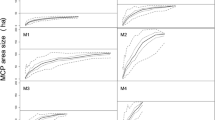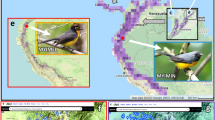Abstract
Foraging with others can reduce predation risk but may increase competition for resources. Species, sex, or age classes may use different niches to reduce competition for food, which may be enforced by social dominance or may lead to ecological specialization. An alternate hypothesis is that individuals using resource patches that renew over time intentionally avoid recently depleted patches by avoiding each other. We tested these hypotheses by simultaneously radio-tracking northern flicker (Colaptes auratus) mates. Members of a pair rarely foraged in the same patch, spending over 90 % of the time >50 m apart. Counter to the ecological specialization hypothesis, the types of ground cover used for foraging and the distance of foraging patches from cover and edge did not differ between males and females. Mates were more spatially segregated on the home range than random and males foraged closer to the nest than females, but we never saw agonistic behaviors counter to the dominance hypothesis. Both sexes avoided returning to the same foraging location repeatedly, perhaps because of prey depletion. We suggest that members of a pair avoided foraging close to each other to reduce encounters with depleted prey patches. We emphasize the importance of simultaneous tracking of mates to identify foraging strategies and potential niche segregation at the home range scale.



Similar content being viewed by others
References
Aho T, Kuitunen M, Suhonen J, Hakkari T, Jäntti A (1997) Effects of male removal on female foraging behavior in the Eurasian treecreeper. Behav Ecol Sociobiol 41:49–53
Ardia DR, Bildstein KL (1997) Sex-related differences in habitat selection in wintering American kestrels, Falco sparverius. Anim Behav 53:1305–1311
Arroyo B, Amar A, Leckie F, Buchanan GM, Wilson JD, Redpath S (2009) Hunting habitat selection by hen harriers on moorland: implications for conservation and management. Biol Conserv 142:586–596
Benkman CW (1988) Flock size, food dispersion and the feeding behavior of crossbills. Behav Ecol Sociobiol 23:167–175
Charnov EL (1976) Optimal foraging, the marginal value theorem. Theor Popul Biol 9:129–136
Conradt L (2005) Definitions, hypotheses, models and measures in the study of animal segregation. In: Ruckstuhl KE, Neuhaus P (eds) Sexual segregation in vertebrates: ecology of the two sexes. Cambridge University Press, New York, pp 11–32
Davies NB, Houston AI (1981) Owners and satellites: the economics of territory defence in the pied wagtail. J Anim Ecol 50:157–180
Desrochers A (1989) Sex, dominance and microhabitat use in wintering black-capped chickadees: a field experiment. Ecology 70:636–645
Elchuk CL, Wiebe KL (2002) Food and predation risk as factors related to foraging locations of northern flickers. Wilson Bull 114:349–357
Elchuk CL, Wiebe KL (2003a) Home-range size of northern flickers (Colaptes auratus) in relation to habitat and parental attributes. Can J Zool 81:954–961
Elchuk CL, Wiebe KL (2003b) Ephemeral food resources and high conspecific densities as factors explaining lack of feeding territories in northern flickers (Colaptes auratus). Auk 120:187–193
Elgar MA (1989) Predator vigilance and group size in mammals and birds: a critical review of the empirical evidence. Biol Rev 64:13–33
Enoksson B (1988) Age- and sex- related differences in dominance and foraging behaviour of nuthatches Sitta europaea. Anim Behav 36:231–238
Evans ML, Stutchbury BJM, Woolfenden BE (2008) Off-territory forays and genetic mating system of the wood thrush (Hylocichla mustelina). Auk 125:67–75
Feinsinger P, Chaplin SB (1975) On the relationship between wing disc loading and foraging strategy in hummingbirds. Am Nat 109:217–224
Franzreb KE (2010) Red-cockaded woodpecker male/female foraging differences in young forest stands. Wilson J Ornithol 122:244–258
Gorrell JV, Ritchison G, Morton ES (2005) Territory size and stability in a sedentary neotropical passerine: is resource partitioning a necessary condition? J Field Ornithol 76:395–401
Gow EA, Wiebe KL (2014) Survival and habitat selection by fledgling northern flickers in a fragmented forest. J Wildl Manag 78:273–281
Gow EA, Musgrove AB, Wiebe KL (2013a) Brood age and size influence sex-specific parental provisioning patterns in a sex-role reversed species. J Ornithol 154:525–535
Gow EA, Wiebe KL, Higgins RJ (2013b) Lack of diet segregation during breeding by male and female northern flickers foraging on ants. J Field Ornithol 84:262–269
Hogstad O (2009) Sexual differences of labour during breeding activities and territory use in the lesser spotted woodpecker Dendrocopos minor. Ornis Norv 32:42–48
Hogstad O (2010) Sexual differences in foraging behaviour in the lesser spotted woodpecker Dendrocopos minor. Ornis Norv 33:135–146
Holmes RT (1986) Foraging patterns of forest birds: male-female differences. Wilson Bull 98:196–213
Jenkins JM (1979) Foraging behavior of male and female Nuttall’s woodpeckers. Auk 96:418–420
JMP®, Version 10 (2013) SAS Institute Inc Cary, N.C
Kamil AC, van Riper IIIC (1982) Within-territory division of foraging space by male and female amakihi (Loxops virens). Condor 84:117–119
Kilham L (1965) Differences in feeding behavior of male and female hairy woodpeckers. Wilson Bull 77:134–145
Krause J, Ruxton GD (2002) Living in groups. Oxford University Press, New York
Krebs JR, MacRoberts BR, Cullen JM (1972) Flocking and feeding in the great tit Parus major—an experimental study. Ibis 114:507–530
Ligon JD (1968) Sexual differences in foraging behavior in two species of Dendrocopos woodpeckers. Auk 85:203–215
Marra PP, Sherry TW, Holmes RT (1993) Territorial exclusion by a long-distance migrant warbler in Jamaica: a removal experiment with American redstarts (Setophaga ruticilla). Auk 110:565–572
McCune B, Grace JB (2002) Analysis of ecological communities. MjM Software Design, Gleneden Beach
Morimoto DC, Wasserman FE (1991) Intersexual and interspecific differences in the foraging behavior of rufous-sided towhees, common yellowthroats and prairie warblers in the pine barrens of southeastern Massachusetts. J Field Ornithol 62:436–449
Morse DH (1977) Feeding behavior and predator avoidance in heterospecific groups. Bioscience 27:332–339
Morton ES (1990) Habitat selection by sex in the hooded warbler: experiments on proximate causation and discussion of its evolution. Am Nat 135:319–333
Oksansen J, Blanchett FG, Kindt R, Legendre P, Minchin PR et al (2012) Vegan: community ecology package. R-package version 2.0–3.0. http://cran.r-project.org/web/packages/vegan/index.html
Pasinelli G (2000) Sexual dimorphism and foraging niche partitioning in the middle spotted woodpecker Dendrocopos medius. Ibis 142:635–644
Pechacek P (2006) Foraging behavior of Eurasian three-toed woodpeckers (Picoides tridactylus alpinus) in relation to sex and season in Germany. Auk 123:235–246
Peters DWM, Grubb JTC (1983) An experimental analysis of sex-specific foraging in the downy woodpecker Picoides pubescens. Ecology 64:1437–1443
R Core Development Team (2012) R: a language and environment for statistical computing, version 2.14.2 R Foundation for Statistic Computing, Vienna, Austria
Radford AN, duPlessis MA (2003) Bill dimorphism and foraging niche partitioning in the green woodhoopoe. J Anim Ecol 72:258–269
Rands SA, Cowishaw G, Pettifor RA, Rowcliffe JM, Johnstone RA (2003) Spontaneous emergence of leaders and followers in foraging pairs. Nature 423:432–434
Robins JD (1971) Differential niche utilization in a grassland sparrow. Ecology 52:1065–1070
Rudolph DC, Conner RN, Schaefer RR, Koerth NE (2007) Red-cockaded woodpecker foraging behavior. Wilson J Ornithol 119:170–180
Selander RK (1966) Sexual dimorphism and differential niche utilization in birds. Condor 68:113–151
Stenberg I, Hogstad O (2004) Sexual dimorphism in relation to winter foraging in the white-backed woodpecker (Dendrocopos leucotos). J Ornithol 145:321–326
Stutchbury BJM, Woolfenden BE, Fedy BC, Morton ES (2005) Nonbreeding territorial behavior of two congeneric antbirds, chestnut-backed antbird (Myrmeciza exsul) and white-bellied antbird (M. longipes). Ornithol Neotrop 16:397–404
Sunde P, Bølstad MS, Møller JD (2003) Reversed sexual dimorphism in tawny owls, Strix aluco, correlates with duty division in breeding effort. Oikos 101:265–278
Swihart RK, Johnson SG (1986) Foraging decisions of American robins: somatic and reproductive tradeoffs. Behav Ecol Sociobiol 19:275–282
Temeles EJ (1986) Reversed sexual size dimorphism: effect on resource defense and foraging behaviors of nonbreeding northern harriers. Auk 103:70–78
Temeles EJ, Roberts WM (1993) Effect of sexual dimorphism in bill length on foraging behavior: an experimental analysis of hummingbirds. Oecologia 94:87–94
Thomson JD (1996) Trapline foraging by bumblebees: I. Persistence of flight-path geometry. Behav Ecol 7:158–164
Wasserman FE (1986) Sexual differences in spatial distribution of foraging white-throated sparrows (Zonotrichia albicollis). Auk 103:421–423
Wiebe KL (2008) Division of labour during incubation in a woodpecker Colaptes auratus with reversed sex roles and facultative polyandry. Ibis 150:115–124
Wiebe KL, Moore WS (2008) Northern flicker (Colaptes auratus). In: Poole A (ed) The birds of North America Online. Cornell Lab of Ornithology, Ithaca, NY, USA. http://bna.birds.cornell.edu/species/166a. Accessed 26 Sept 2014
Williams JB (1980) Intersexual niche partitioning in downy woodpeckers. Wilson Bull 92:439–451
Acknowledgments
We thank J. Allsop, B. Griffiths, H. Hanbridge, M. Mitsutani, A. Musgrove, and M. Van der Pol for their help in the field. This research was funded by the Kenneth Molson Foundation, National Sciences and Engineering Research Council (NSERC) Discovery (KLW), NSERC Canada Graduate Scholarship (EAG), the Society of Canadian Ornithologists, and the Isabel Maria López Matínez Memorial Scholarship (EAG).
Ethical standards
Our research was conducted in accordance with the Canadian Council on Animal Care guidelines for birds and was approved by the University of Saskatchewan Animal Care Committee (Animal Care Permit 20010113).
Author information
Authors and Affiliations
Corresponding author
Additional information
Communicated by S. Pruett-Jones
Rights and permissions
About this article
Cite this article
Gow, E.A., Wiebe, K.L. Northern flicker mates foraging on renewing patches within home ranges avoid competition not by separate niches but by segregation. Behav Ecol Sociobiol 69, 101–108 (2015). https://doi.org/10.1007/s00265-014-1822-8
Received:
Revised:
Accepted:
Published:
Issue Date:
DOI: https://doi.org/10.1007/s00265-014-1822-8




